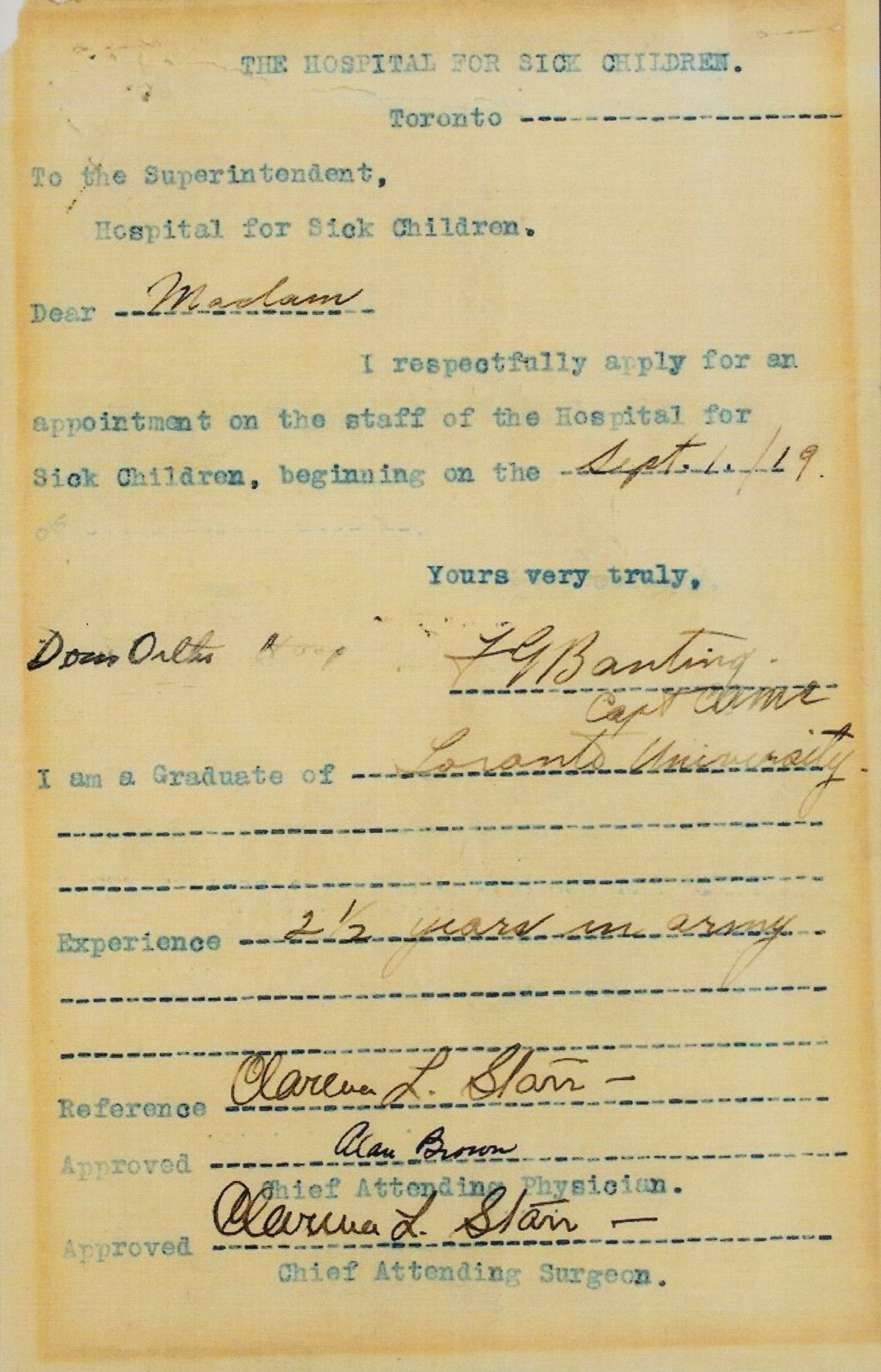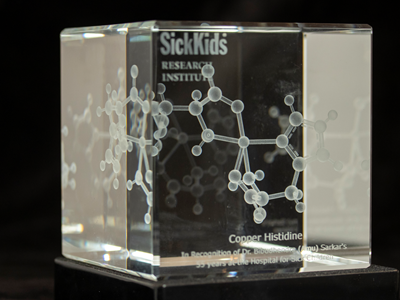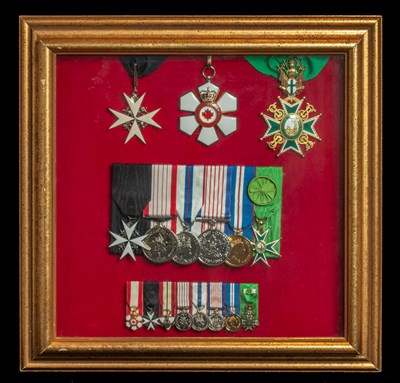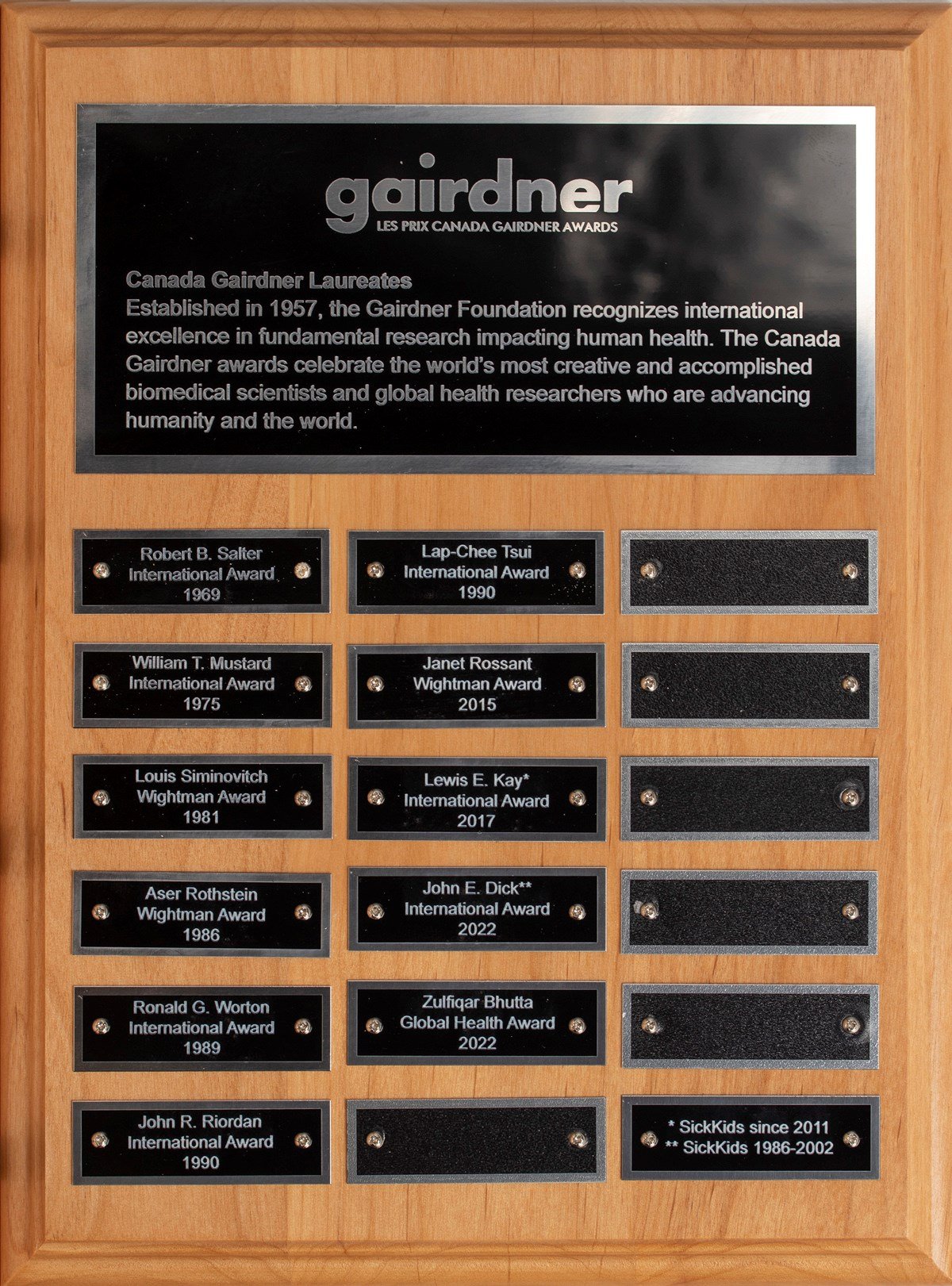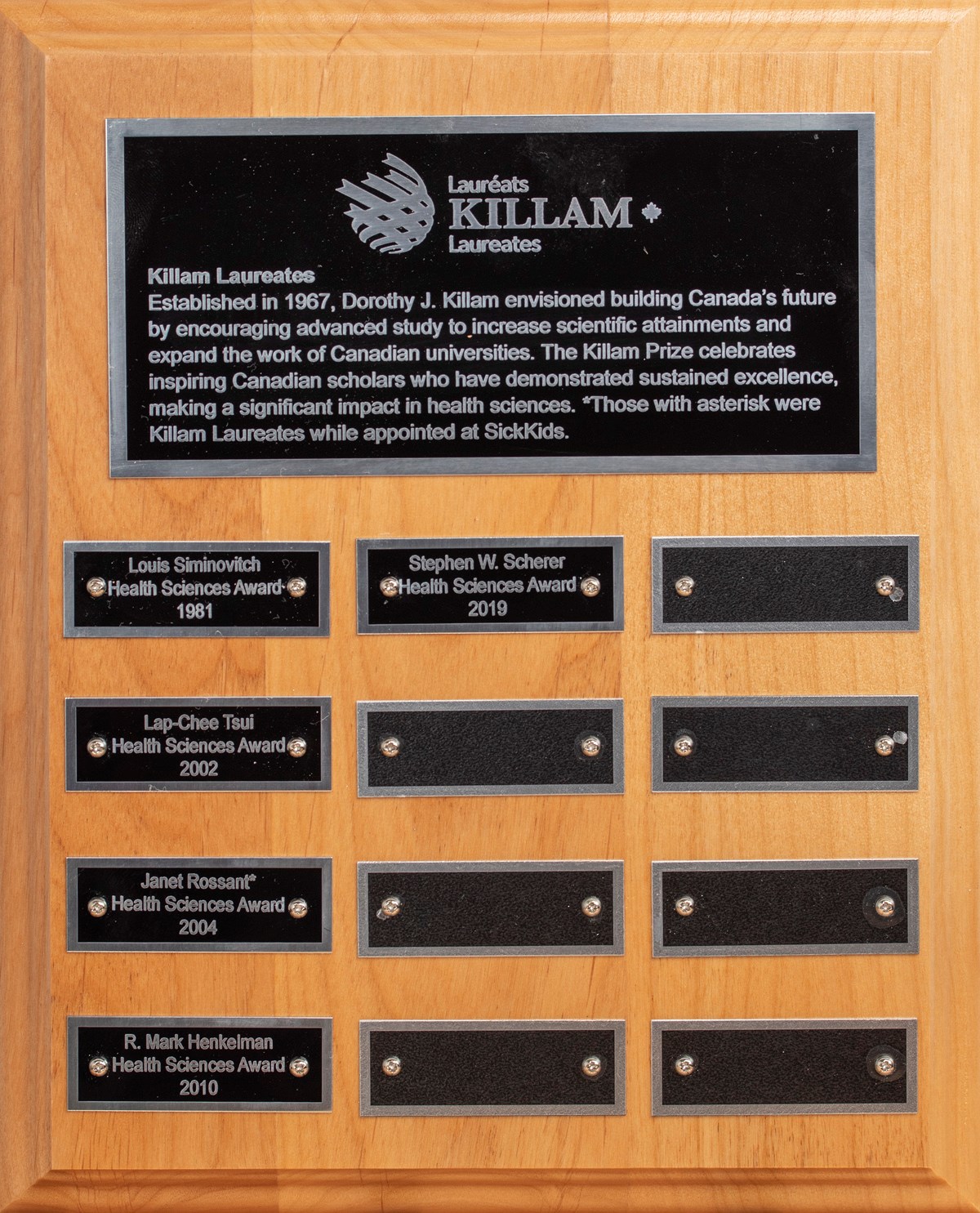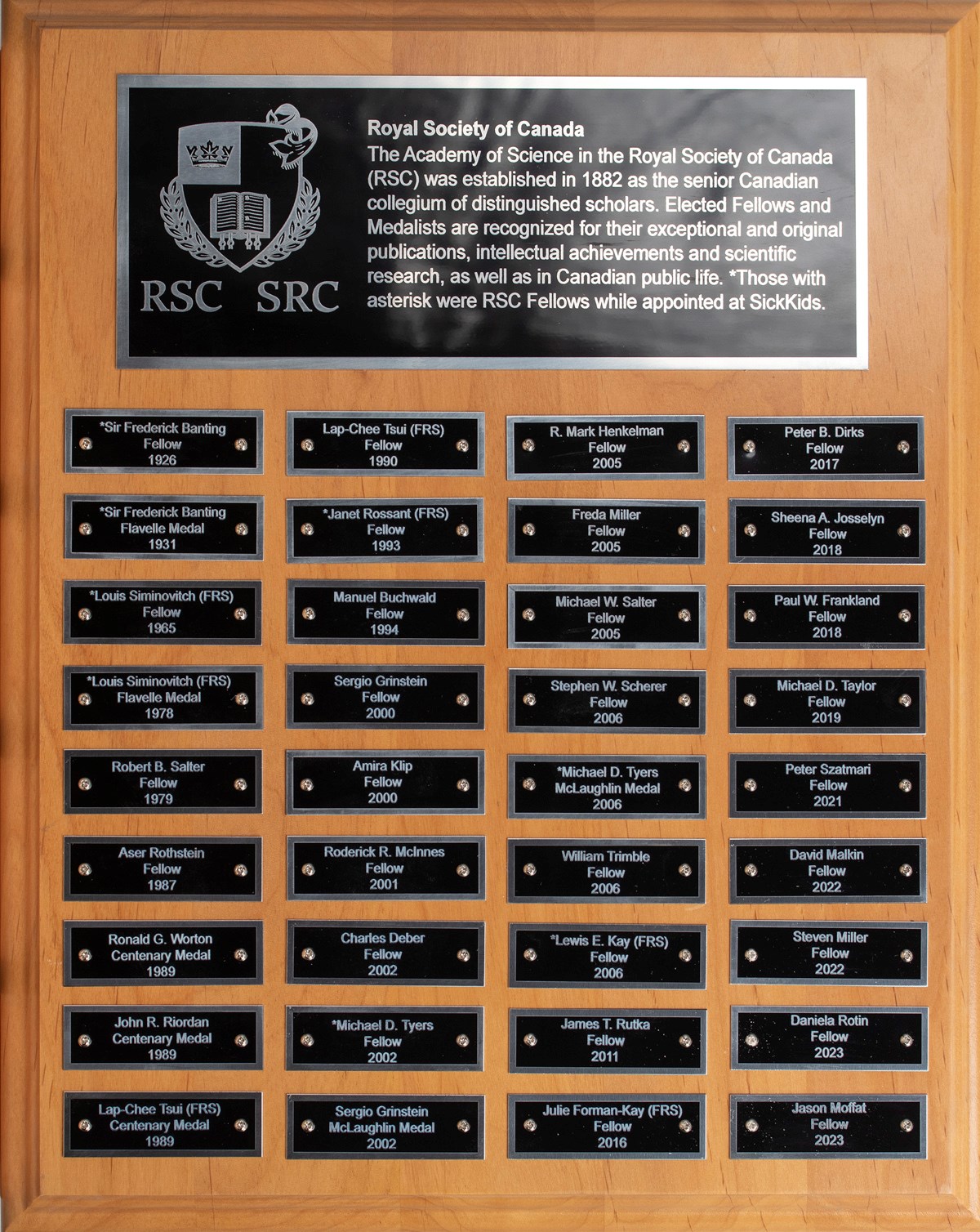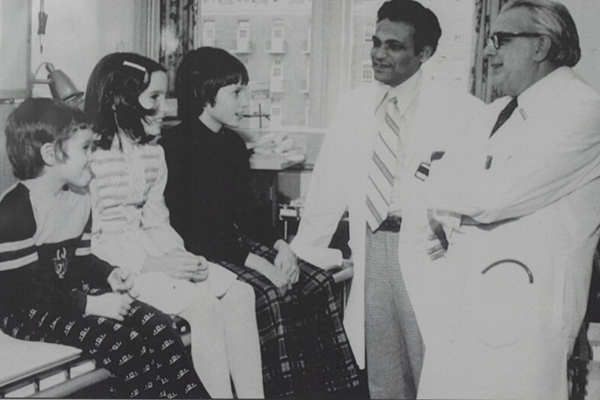
Awards & Memorabilia
Banting's application to SickKids
This is an image of Dr. Frederick Banting's 1919 job application to work as a surgical resident (1919–1920) at SickKids after he returned from the war. In 1923 Dr. Banting returned to SickKids as an “Active Staff – Department of Medicine”, and continued to be listed as staff into WWII, at which point he is also listed as “on active service,” and continues to be on our staff lists until his death in 1941. One of the greatest medical breakthroughs in history, insulin was discovered by Dr. Banting alongside Drs. Charles H. Best and J.J.R. Macleod in 1921 at the University of Toronto. This document represents a crucial moment in Banting's journey and highlights the significant contributions he would later make in the field of medicine, ultimately revolutionizing the treatment of diabetes. Sir Frederick Banting won the Nobel Prize in Physiology or Medicine “for the discovery of insulin” in 1923.
Excerpts from Dr. Frederick Banting's Nobel Award Speech
Dr. Banting's Nobel Prize acceptance speech references Dr. Gladys Boyd, Head of the SickKids Diabetes Program. Boyd administered insulin to Elise Needham, an eleven-year-old girl who is the first child in the world to recover from a diabetic coma.
Excerpts from Dr. Oliver Smithies' Nobel Award Speech
Dr. Oliver Smithies Nobel Prize speech references Dr. Norma Ford Walker, the SickKids scientist who treated and co-wrote the book "A Biological Study of the Dionne Quintuplets." Ford Walker completed her PhD in Zoology at the University of Toronto in 1923. From 1947 to 1962, Dr. Ford Walker was the first Geneticist-in-Chief at SickKids. She taught Smithies genetics in her lab and with him, demonstrated that haptoglobin types were inherited.
Canada Foundation for Innovation award letter
Received on February 5, 2010, this letter confirms that the Canada Foundation for Innovation approved a $91,119,176 award to SickKids for the building of the new research tower, which was named the Peter Gilgan Centre for Research and Learning in 2012 with the historic $40 million gift from Mr. Peter Gilgan, Founder and CEO of Mattamy Homes. The award from the Canada Foundation for Innovation is the largest grant to date received at SickKids. The awards letter is signed by Dr. Janet Rossant, Chief of Research (2005–2015), Dr. Michael Salter, Chief of Research (2015–2020), and Dr. Stephen Scherer, Chief of Research (appointed 2021). These three, along with Drs. Peter Dirks, Fred Keeley and David Malkin, along with Gwen Burrows, were involved in aspects of writing the successful grant as well as participating in the site visit.
The coat of arms of The Hospital for Sick Children
Designed in 1975 to celebrate the 100th anniversary of the hospital's founding, the coat of arms was created by Dr. Robert Bruce Salter, a world-renowned Orthopaedic Surgeon at SickKids and the University of Toronto. He was a Companion of the Order of Canada, was awarded the Order of Ontario and was inducted into the Canadian Medical Hall of Fame. His entire career was served at SickKids, from 1955 until his death in 2010.
- The red cross of St. George of England on a white background is symbolic of The Hospital for Sick Children, Toronto being named after a similar institution in London, England.
- The white square in the centre of the cross of St. George is the Canadian red maple leaf of the Canadian flag.
- The rod of Aesculapius with a serpent entwined was the attribute of the Greek God of Medicine.
- The lighted lamp of Florence Nightingale recognizes nursing staff.
Together these symbolize the hospital's first responsibility: patient care.
The open book is symbolic of the second responsibility: the teaching of both the undergraduate and post graduate students at the University of Toronto.
The ancient heraldic key, a symbol of mystery or enigma is the third responsibility: research. The key forms the letter ‘E’ for excellence.
Copper histidine molecule
Dr. Bibudhendra (Amu) Sarkar was the first basic scientist hired by the SickKids Research Institute in 1964. Dr. Sarkar's research focused on the significance of metals in biological systems. To celebrate his outstanding contribution to biochemistry, the three-dimensional model of the copper histidine molecule was presented to Dr. Sarkar in February 2020 to commemorate his 55 years of service at SickKids.
Dr. Robert Salter awards
This impressive frame proudly showcases multiple awards received by Dr. Robert (Bob) Salter, a distinguished surgeon-in-chief at SickKids and a pioneer in the field of paediatric orthopaedic surgery. Dr. Salter meticulously assembled this frame himself, reflecting his immense pride in these accolades. Among the notable awards adorning the frame are the Canadian Centennial Medal, the Queen's Silver Jubilee Medal (1977), the 125th Anniversary of the Confederation of Canada Medal, the Queen's Canada Gold Jubilee, the Order of Ontario (1988), the Officer of the Order of Canada medal (1977), the Most Venerable Order of the Hospital of St. John of Jerusalem, and the Order of Saint Lazarus of Jerusalem medal. Each of these honours serves as a testament to Dr. Salter's unwavering commitment to advancing the field of paediatric orthopaedic surgery. Dr. Salter also designed the medical logo of SickKids, which is also shown on the accompanying tie he also designed, which lies at the base.
Gairdner Award plaque
Established in 1957, the Gairdner Foundation recognizes international excellence in fundamental research impacting human health. The Canada Gairdner awards celebrate the world’s most creative and accomplished biomedical scientists and global health researchers who are advancing humanity and the world.
Killam Award plaque
Established in 1967, Dorothy J. Killam envisioned building Canada’s future by encouraging advanced study to increase scientific attainments and expand the work of Canadian universities. The Killam Prize celebrates inspiring Canadian scholars who have demonstrated sustained excellence, making a significant impact in health sciences.
Royal Society of Canada Award plaque
The Academy of Science in the Royal Society of Canada (RSC) was established in 1882 as the senior Canadian collegium of distinguished scholars. Elected Fellows and Medalists are recognized for their exceptional and original publications, intellectual achievements, and scientific research, as well as in Canadian public life.
The Centre for Applied Genomics 25th Anniversary
Founded by Dr. Lap-Chee Tsui and Dr. Stephen Scherer, The Centre for Applied Genomics (TCAG) is dedicated to conducting and promoting groundbreaking research in genomics including service and training support for academic, government, and private sector scientists worldwide. TCAG is part of CGEn, established in 2015 with McGill University and the University of British Columbia, an Canada Foundation for Innovation Major Science Initiative. On September 19, 2023, TCAG celebrated its 25th Anniversary with a symposium featuring previous TCAG staff and users. The Inukshuk - meaning "in the likeness of a human" - for TCAG represents the many thousands of SickKids patients, research participants, and people from all over the world, who have had their DNA sequenced at TCAG. This gift was given to speakers and key guests of the symposia.


